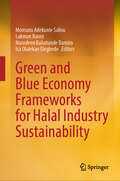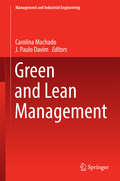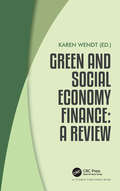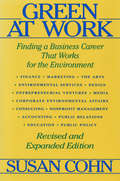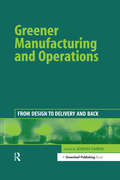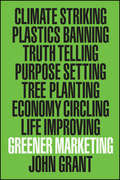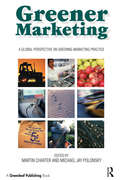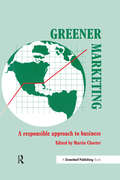- Table View
- List View
Green Washed
by Kendra Pierre-LouisThe message that our environment is in peril has filtered from environmental groups to theAmerican consciousness to our shopping carts. Every day, millions of Americans dutifully replace conventional produce with organic, swap Mr. Clean for Seventh Generation, and replace their bottled water with water bottles. Many of us have come to believe that the path to environmental sustainability is paved by shopping green. Although this green consumer movement certainly has many Americans consuming differently, it raises an important and rarely asked question--"is this consumption really any better for the planet?" By examining the major economic sectors of our society, including infrastructure (green housing), consumer goods (green clothing and jewelry), food (the rise of organic), and energy (including solar power and the popularity of the hybrid car), Green Washed: Why We Can't Buy Our Way to a Green Planet explains that, though greener alternatives are important, we cannot simply buy our way to sustainability. Rather, if it is the volume of our consumption that matters, can we as a society dependent on constantly consuming ever be content with buying less? A new and unique take on green consumption, Green Washed shows how buying better is only the first step toward true sustainability. Kendra Pierre-Louis is the sustainable development editor for Justmeans.com. She holds a master's degree in sustainable development from the SIT Graduate Institute in Vermont. She has created outreach material for the United Nations Environment Programme's Convention on Biological Diversity and worked as a researcher for Terrapin Bright Green, an environmental consulting and strategic planning firm.
Green Wealth
by Kevin F. Noon Judith A. WardOnly a fraction of this country&’s land can be farmed or developed. What happens to the land that is not economically viable? Until a few years ago, the value of such property would have remained flat, with little prospect of appreciating. Today, however, the Federal government has created a huge incentive to turn this land into moneymaking assets. Green Wealth explains how newly enacted laws can benefit those who invest in environmentally reconstituted land development.The Feds, along with many state governments, now allow for the creation of individual environmental &“banks,&” which are established by converting unproductive property into new wetlands, endangered species reserves, water storage reservoirs, and a host of other types of environmentally protected land. Credits are then issued to the landowners—credits that can be sold to developers seeking to build on previously protected properties. As building continues in one place, new environmentally sound acreage is created in another. Now you can perform an environmentally responsible service and make a highly profitable investment at the same time.
Green Your Work
by Kim CarlsonToday, many companies are flourishing by delivering high-quality products while pursuing policies that leave the world a cleaner, better place. Those policies can help retain customers, energize employees, and serve as brand-building tools. This book shows managers practical steps to make their companies environmentally responsible while staying profitable and efficient. Environmentalist and businesswoman Kim Carlson shows managers how to green company operations by moving to a paperless office, recycling at work, setting up employee carpools, developing eco-friendly packaging, using green building products, and more. She explains in detail topics ranging from green marketing to setting up a carbon footprint assessment for the company. With this book at their side, managers can turn green into profits.
Green Your Work: Boost Your Bottom Line While Reducing Your Carbon Footprint
by Kim CarlsonToday, many companies are flourishing by delivering high-quality products while pursuing policies that leave the world a cleaner, better place. Those policies can help retain customers, energize employees, and serve as brand-building tools. This book shows managers practical steps to make their companies environmentally responsible while staying profitable and efficient. Environmentalist and businesswoman Kim Carlson shows managers how to green company operations by moving to a paperless office, recycling at work, setting up employee carpools, developing eco-friendly packaging, using green building products, and more. She explains in detail topics ranging from green marketing to setting up a carbon footprint assessment for the company. With this book at their side, managers can turn green into profits.
Green and Blue Economy Frameworks for Halal Industry Sustainability
by Lukman Raimi Monsuru Adekunle Salisu Nurudeen Babatunde Bamiro Isa Olalekan ElegbedeThis book serves as a valuable resource for economic policymakers, economic analysts, halal trainers, halal stakeholders, agribusiness advocates, and halal industry consultants in the rapidly changing emerging green and blue economy. The book explores the themes of green and blue economies for halal industry sustainability and business entrepreneurship as well as production and consumption, ethics and impact investments in halal, green and blue entrepreneurship, and principles governing the innovation of production framework through integration of green and blue economy. The green and blue economy frameworks can be applied to the Halal industry to enhance its sustainability and promote environmental and social responsibility. This book presents the emerging blue and green economy to halal entrepreneurs as a complementary alternative model for enterprise development, wealth creation, employment creation, responsible production, and sustainable consumption and a catalyst for attaining sustainable development goals.
Green and Competitive: Ending the Stalemate
by Michael E. Porter Claas Van Der LindeThe lingering belief that environmental regulations erode competitiveness has resulted in a stalemate. One side pushes for tougher standards, the other tries to roll standards back. The authors' research shows that tougher environmental standards actually can enhance competitiveness by pushing companies to use resources more productively. Managers must start to recognize environmental improvement as an economic and competitive opportunity, not as an annoying cost or an inevitable threat. Environmental progress demands that companies innovate to raise resource productivity--precisely the new challenge of global competition. It is time to build on the underlying economic logic that links the environment, resource productivity, innovation, and competitiveness.
Green and Lean Management
by J. Paulo Davim Carolina MachadoThis book focusses on the challenges and changes organizational management faces in an era when the need to develop environmentally aware processes meets high levels of competition. It covers the synergetic effects, how re-use, recycling, waste reduction, and other sustainable production strategies can add value, low costs and time of production. Sustainable business behavior is not only an environmental perspective on management, but more and more contains an organizational perspective. Taking into account these issues, green and lean management appears as the way managers can drive their employees to continuously improve the management processes that add value to the organization and costumers. This book provides information on principles, strategies, models, and applications of green and lean management, and at the same time communicates the latest research activity relating to this scientific field world-wide.
Green and Social Economy Finance: A Review
by Karen WendtGreen and Social Economy Finance is a compilation of chapters by experts, linking research and practice. This anthology provides a new thinking on social economy green finance, showing emerging themes and trends. It spans from stock markets, green finance, innovations, digitalization to social finance, governance and theories of change. It concentrates on impact, opportunity recognition and development of financial products designed to finance the green and social economy. Without the attraction of capital, social entrepreneurship, and innovations, green finance can face difficulty in addressing business solutions. Green and social economy is a nascent field. The authors address the conceptualization of green and social solutions and identify new trends in the finance industry products and approaches. The book demonstrates that aligning finance and investment with the Paris Agreement, sustainable development goals and needs and interests of society are feasible.
Green and Sustainable Finance: Principles and Practice (Chartered Banker Series #6)
by Simon ThompsonMore than 120 countries have committed to net zero targets by 2050, requiring systemic economic transitions on an unprecedented scale and with the finance sector playing a leading role. Green finance will power the transition, ensuring capital flows to the firms, investments, projects and technologies looking to create a sustainable, low-carbon world. To achieve net zero, every professional financial decision must take climate change and broader sustainability factors into account. Green and Sustainable Finance provides a comprehensive guide to the application of common green and sustainable principles and practices in banking, investment and insurance to help finance professionals embed these in their daily activities and decision-making. Focusing on the necessity of mainstreaming green and sustainable finance globally, this book includes a clear explanation of the science underpinning climate change. Green and Sustainable Finance covers a wide range of green finance products and services in retail, commercial and corporate banking, insurance, investment and fintech. It provides an overview of emerging regulation and international market frameworks and standards, particularly in relation to climate and environmental risk. Consideration is also given to the ethical dimensions of green and sustainable finance, including how professionals can promote market integrity and take active steps to avoid greenwashing. Endorsed by the Chartered Banker Institute as the core text for the benchmark Certificate in Green and Sustainable Finance, this book is essential reading for finance professionals and students, and individuals working to embed sustainability in business, policy and regulation.
Green and Sustainable Finance: Principles and Practice in Banking, Investment and Insurance (Chartered Banker Series #7)
by Simon ThompsonTo achieve society's goals, as set out in the UN Sustainable Development Goals and the Paris Agreement, the finance sector has a crucial role to play in driving sustainable business and the transition to a net zero economy.To achieve this change, it is vital for the finance sector to allocate capital to the firms, investments and activities looking to create a more sustainable world. Green and Sustainable Finance offers a comprehensive guide to green and sustainable principles and practice in banking, investment and insurance to help finance professionals manage sustainability risks and support their clients and customers in transition. Given the need for urgent, rapid and sustained change, it is essential that all finance professionals understand and apply these principles so that every professional financial decision takes account of sustainability.Written by the CEO of the Chartered Banker Institute this fully updated second edition includes the most recent assessments of climate science from the IPCC, extended coverage of sustainability reporting and carbon accounting, and regulatory and market developments in sustainability risk management. It also features material on the rapid growth of sustainable lending and investment and the latest finance sector alliances and initiatives. Endorsed by the Chartered Banker Institute as the core text for the global benchmark Certificate in Green and Sustainable Finance, this book is essential reading for finance professionals, university students and individuals working to embed sustainability in business, finance, policy and regulation.
Green and Sustainable Finance: Principles and Practice in Banking, Investment and Insurance (Chartered Banker Series)
by Simon ThompsonThe finance sector has a crucial role to play in delivering a sustainable future for the planet. To address the Triple Planetary Crisis of climate change, pollution and biodiversity loss, it is vital that the finance sector rapidly accelerates the mobilization of capital to support a successful and just transition to net zero. This requires enhancing both the capabilities of financial institutions and developing the knowledge and skills of finance professionals so that every financial decision takes account of climate change and sustainability.Green and Sustainable Finance is a comprehensive guide to the principles and practice required to manage sustainability risks, engage and support clients, and take advantage of the opportunities presented by the transition of sectors and firms to new, low carbon and nature positive models.This fully updated third edition incorporates a wider perspective with nature-based impacts, risks, dependencies and opportunities considered alongside climate change. It introduces the work of the new International Sustainability Standards Board (ISSB) and the Taskforce on Nature-related Financial Disclosures (TNFD) along with extensive coverage of wider regulatory and market developments. There is also additional content on adaptation finance, transition finance and transition planning. Endorsed by the Chartered Banker Institute as the core text for the global benchmark Certificate in Green and Sustainable Finance, this book is essential reading for finance professionals, university students and individuals working to embed sustainability in business, finance, policy and regulation.
Green at Work: Finding a Business Career that Works for the Environment
by Horst Rechelbacher Susan Cohn Lynda GroseGreen at Work, published by Island Press in 1992, was the first source of information to help nontechnical but environmentally concerned job seekers learn about career opportunities with environmental companies or within the newly emerging "green" corporate culture. Now entirely revised and expanded, this indispensable volume again offers invaluable tools and strategies for launching a green career.Susan Cohn has expanded her scope beyond the business world to examine environmentally focused, nontechnical careers in a wide variety of fields, including communications, banking and finance, consulting, public policy, the non-profit sector, and more. This completely updated edition includes: profiles of more than 70 individuals that illustrate how people have woven their skills, values, and passions into their work listings of more than 400 companies with contact names, addresses, phone numbers, information on what the company does, and its environmental programs and policies listings of more than 50 resources, including organizations, publications, and other sources of information a bibliography of recommended readings
Green with Envy: Why Keeping Up with the Joneses Is Keeping Us in Debt
by Shira BossA silent struggle with our money is raging. Each of us, regardless of income, occupation, or net worth, is harboring desires and discontents in our personal financial lives. That's because our financial contentment is based on how we measure up to those around us and how close we come to the image we feel compelled to live up to. But how can we make realistic comparisons to others when everyone hides what's really going with their personal finances? To make matters worse, in our striving to keep up with the Joneses, we make financial messes and shroud them with secrecy and shame.This book reveals the gap between the reality of our private financial lives and the facade we present to the outside world. It cracks the taboo of money by peering into the lives of those who surround us and showing what really goes on with their checkbooks and inside their heads.
GreenFire Energy, 2020: Geothermal Innovation
by John R. Wells Benjamin WeinstockIn June 2020, GreenFire Energy Inc. (GreenFire) presented its report to the California Energy Commission indicating that its proof of concept project to demonstrate its new geothermal electricity generation technology, ECO2G , had been a success. While conventional geothermal electricity only supplied 0.5% of US demand, the new technology promised to increase this to 25% by drilling much deeper. Moreover, it was a closed-loop system which didn't involve fracking like conventional geothermal and promised to be much more cost effective. Unlike other renewables, ECO2G could also provide baseload power 24 hours a day and be adjusted quickly to match demand. CEO Joseph Scherer likened it to the beginning of the oil rush. "When the oil industry first started, prospectors focused on places where oil was seeping out of the ground. Now, they drill for it in deep oceans. Same with geothermal, but geothermal is much easier to find, and there is a lot more of it!" Now Scherer and John Muir, brother of founder Mark Muir, had to choose how they would commercialize the technology. They had many choices.
GreenLight BioSciences: In Search of Impact Investment
by Annelena Lobb Michael Chu Joni CoughlinGreenlight Biosciences, a biotech company is in search of impact investment for its next round of financing.
Greenback Planet: How the Dollar Conquered the World and Threatened Civilization as We Know It (Discovering America)
by H. W. BrandsFrom the New York Times–bestselling historian and two-time Pulitzer Prize finalist, &“[a] compact summation of our nation&’s monetary history&” (Shepherd Express). The world runs on the US dollar. From Washington to Beijing, governments, businesses, and individuals rely on the dollar to conduct commerce and invest profitably and safely. But how did the greenback achieve this planetary dominance a mere century and a half after President Lincoln issued the first currency backed only by the credit—and credibility—of the federal government? In Greenback Planet, acclaimed historian H. W. Brands charts the dollar&’s astonishing rise to become the world&’s principal currency. Telling the story with the verve of a novelist, he recounts key episodes in U.S. monetary history, from the Civil War debate over fiat money (greenbacks) to the recent worldwide financial crisis. Brands explores the dollar&’s changing relations to gold and silver and to other currencies and cogently explains how America&’s economic might made the dollar the fundamental standard of value in world finance. He vividly describes the 1869 Black Friday attempt to corner the gold market, banker J. P. Morgan&’s bailout of the U.S. treasury, the creation of the Federal Reserve, and President Franklin Roosevelt&’s handling of the bank panic of 1933. Brands shows how lessons learned (and not learned) in the Great Depression have influenced subsequent U.S. monetary policy, and how the dollar&’s dominance helped transform economies in countries ranging from Germany and Japan after World War II to Russia and China today. He concludes with a sobering dissection of the 2008 world financial debacle, which exposed the power—and the enormous risks—of the dollar&’s worldwide reign.
Greenback Planet: How the Dollar Conquered the World and Threatened Civilization as We Know It (Discovering America)
by H. W. BrandsFrom the New York Times–bestselling historian and two-time Pulitzer Prize finalist, &“[a] compact summation of our nation&’s monetary history&” (Shepherd Express). The world runs on the US dollar. From Washington to Beijing, governments, businesses, and individuals rely on the dollar to conduct commerce and invest profitably and safely. But how did the greenback achieve this planetary dominance a mere century and a half after President Lincoln issued the first currency backed only by the credit—and credibility—of the federal government? In Greenback Planet, acclaimed historian H. W. Brands charts the dollar&’s astonishing rise to become the world&’s principal currency. Telling the story with the verve of a novelist, he recounts key episodes in U.S. monetary history, from the Civil War debate over fiat money (greenbacks) to the recent worldwide financial crisis. Brands explores the dollar&’s changing relations to gold and silver and to other currencies and cogently explains how America&’s economic might made the dollar the fundamental standard of value in world finance. He vividly describes the 1869 Black Friday attempt to corner the gold market, banker J. P. Morgan&’s bailout of the U.S. treasury, the creation of the Federal Reserve, and President Franklin Roosevelt&’s handling of the bank panic of 1933. Brands shows how lessons learned (and not learned) in the Great Depression have influenced subsequent U.S. monetary policy, and how the dollar&’s dominance helped transform economies in countries ranging from Germany and Japan after World War II to Russia and China today. He concludes with a sobering dissection of the 2008 world financial debacle, which exposed the power—and the enormous risks—of the dollar&’s worldwide reign.
Greenback: The Almighty Dollar and the Invention of America
by Jason GoodwinEconomic history of money in the US.
Greener Energy Systems: Energy Production Technologies with Minimum Environmental Impact
by Eric JeffsRecent years have seen acceleration in the development of cleaner energy systems. In Europe and North America, many old coal-fired power plants will be shut down in the next few years and will likely be replaced by combined cycle plants with higher-efficiency gas turbines that can start up and load quickly. With the revival of nuclear energy, designers are creating smaller nuclear reactors of a simpler integrated design that could expand the application of clean, emission-free energy to industry. And a number of manufacturers now offer hybrid cars with an electric motor and a gasoline engine to charge the batteries on the move. This would seem to be the way forward in reducing transport emissions, until countries develop stronger electricity supply systems to cope with millions of electric cars being charged daily. Greener Energy Systems: Energy Production Technologies with Minimum Environmental Impact tackles the question of how to generate enough electricity, efficiently and with minimum environmental impact, to meet future energy needs across the world. Supplemented with extensive figures and color photographs, this book: Traces the development of electricity supply Explains energy production risks and how major accidents have influenced development Discusses the combined cycle, the preferred system for power capacity expansion in much of the world Looks at combined heat and power Addresses whether coal can continue to be a fuel for power generation Examines nuclear power generation Asks why shipping has not followed some of the world's navies into nuclear propulsion Considers how to electrify more transport systems Reviews the current state of renewable systems, particularly hydro and solar The book defines the key elements of greener energy systems, noting that they must be highly efficient, with rapid start up and loading; produce minimum emissions; and use simpler technology. The author has more than forty years of experience as an international journalist reporting on power-generation technologies and energy policies around the world. He concludes that there is no place for coal and that combined cycle, hydro, solar, and biomass must complement nuclear energy, which must serve more applications than just generating electricity.
Greener Manufacturing and Operations: From Design to Delivery and Back
by Joseph SarkisThis timely work examines one core corporate function that has a profound and direct impact on corporate environmental performance – manufacturing and operations. This area has been of concern in recent years to researchers and practitioners in fields ranging from the social and natural sciences to management and technical engineering. The book reflects this diversity with global contributions on topics such as design for the environment, total quality environmental management, green supply chains, reverse logistics, environmental management systems and standards, industrial ecology, closed-loop manufacturing, life-cycle management, pollution prevention (P2), environmental technologies and energy efficiency. The aim and scope of Greener Manufacturing and Operations is to capture state-of-the-art and future practices in environmental manufacturing and operations practices and issues in one concise volume. The book is therefore a fluid mix of case studies, empirical research, and applied theoretical works incorporating both conceptual ideas whose time will come to practical applications which managers and practitioners can apply immediately. Comprehensive in its coverage of the key issues, contributions range from a focus on the internal operations of a single function within an organization to a consideration of industrial manufacturing practices from a macro-economic level. A number of levels of decision-making are also represented: from long-term strategic issues such as supply chain design, to traditional short-term operations decision-making and planning issues such as production planning. Many of the principles developed and presented here can also be extended to the more general process management of service organizations. The book is organized into four major sections: operations strategy and policy; manufacturing and operations practice; tools for managing greener operations and manufacturing; and, finally, case studies. Greener Manufacturing and Operations will be an essential aid for managers, engineers, students, researchers, and consultants wishing to understand the various issues, principles, and tools for managing the operations and manufacturing function in a more environmentally-benign and sustainable manner.
Greener Marketing
by John GrantThis timely book is a sequel to John Grant’s Green Marketing Manifesto which was the award winning and bestselling definitive guide to green marketing (and not greenwashing) in the previous wave of eco marketing in 2007. In 2019, climate change is right back at the top of the public agenda. Greta Thunberg and Extinction Rebellion are front page news. The UK, EU and other governments have declared a climate emergency. 181 CEOs of American companies - including Walmart, Amazon and Apple - signed a Business Round Table declaration saying that the purpose of corporations is not just to make money for shareholders, but to improve society, care for the environment and be ethical. Unilever CEO Alan Jope says they will dispose of brands that don’t have a bigger purpose. Concerns like ocean plastic (the ‘Blue Planet effect’) have upped the pace of change. With ambitious responses such as refills stations, unpackaged goods, super-materials from wood fibre and seaweed and a new ‘milkman for groceries’ reusable packaging service called Loop. Sustainable brands are now outperforming others in most markets. Eco challenger brands like VEJA and Allbirds are ‘the new cool’. While Adidas showed (with Parlay ocean plastic shoes) you can also create a billion dollar mainstream offer. Even banking is changing, with rapid growth in ESG and Impact Investing. Plus, the $40Bn overnight success of sustainability linked loans to companies like Philips and Prada. How can marketing and the creative industries respond? Even Extinction Rebellion thinks we can play a positive role – although XR also say it has to go beyond banning plastic straws - if we can only manage to tell the truth and lead the change. Hundreds of creative agencies and brands came out on climate strike and donated ideas: Or in the case of Patagonia donated their entire $10m tax windfall to environmental causes. But what now? How do you set a positive course? In this book we look at some of the leaders – brands like Patagonia and Max Burgers aiming to be climate positive. And we look at brands who have found a fresh sense of purpose by championing a relevant cause. The book is packed with case studies, tools, research insights. Covering issues like eco labelling, transparency, circular economy, rebound effects, impact investment, new coalitions and developments ranging from sustainable finance, to blockchain and traceability, to regenerative farming. One key theme that carries over from the Green Marketing Book is that marketers need to know their facts if attempts are not to be superficial. When you know 95% of the energy footprint of a mobile phone is in manufacturing and materials (not charging the battery) you know that getting people to dim their screen won’t save much CO2. But that getting them to keep their phone in use for an extra year is a huge win for the planet. The ultimate goal is to go beyond marketing that simply looks good, and to create a vision of marketing that does good. Uncover strategies for sustainable marketing that actually deliver on green and social objectives, not just greenwashing Reconceptualise marketing and business models, and learn to recognise the commercial strategies and approaches that are no longer fit for purpose Learn how hot topics like the climate crisis, single use plastics, and blockchain technology influence green and social marketing Read examples and case studies from both brand leaders and challengers that have developed innovations and fresh creative approaches to green and social marketing Get practical tools, models, facts, plus strategy, workshop and project processes and business case rationales - so that you can build your own plans and proposals This book is intended to assist marketers, by means of clear and practical guidance, through a comp
Greener Marketing: A Global Perspective on Greening Marketing Practice
by Martin Charter Michael Jay PolonskyBuilding on the strengths of the material published in the hugely successful first edition of Greener Marketing, this important new title examines on a global scale the progress of environmental marketing in the 1990s and considers how social issues are increasingly becoming critical factors in how corporations meet the ever-growing demands and expectations of customers. Despite the fact that such issues are increasingly important in marketing activities around the world, it is difficult for practitioners to keep up to date with complex and rapidly changing information and ideas. The purpose of this book is to provide practitioners and academics with best-practice examples and actionable recommendations on how to implement and appraise green marketing activities. It will provide information and ideas for those involved in marketing on how to incorporate environmental and social considerations, as well as providing new perspectives on marketing for environmental managers. To achieve a comprehensive viewpoint, the book is split into three sections. The first sets out the strategic issues and rationale for green marketing, the second addresses tactical issues in more detail, and the third provides detailed international case studies. Topics addressed by the global set of contributors include the growing area of products versus services, environmental product development, green marketing alliances, environmental communications, green consumers, eco-tourism and environmental marketing in developing countries. reener Marketing is not only a sequel to the successful first volume, but redefines global progress towards the successful marketing of greener products and services.
Greener Marketing: A Responsible Approach to Business
by Martin CharterAn examination of the progress of environmental marketing on a global scale. It considers how sustainability issues are increasingly becoming critical factors in how corporations meet the ever-growing demands and expectations of customers. The purpose of the book is to provide practitioners with best-practice examples and actionable recommendations on how to implement green marketing activities. It provides information and ideas for those involved in marketing on how to incorporate green considerations into the marketing mix, as well as providing perspectives on marketing for environmental managers. To achieve a comprehensive viewpoint, the book is split into three sections. The first sets out the strategic issues and rationale for green marketing, the second addresses tactical issues in more detail, and the third provides detailed, international case studies. Topics addressed by the contributors include the growing debate around products versus services, environmental product development and eco-innovation, green marketing alliances, environmental communications, green consumers, eco-tourism and the problems associated with green marketing in developing countries.
Greener Products: The Making and Marketing of Sustainable Brands
by Al IannuzziSustainability and its competitive advantage are the goals of every company and any brand that wants to stay successful in the marketplace. Customers also gravitate to brands that manage sustainability issues well. Greener Products: The Making and Marketing of Sustainable Brands written by a renowned sustainability expert, continues to address the latest developments in the extremely fast-moving field of sustainability. The third edition is thoroughly updated, introduces new case studies, and includes a new chapter on green marketing. With over 40 case studies, it explores the best practices of leading global companies and helps readers learn what it is that makes them successful.New in the Third Edition: Presents, in a practical way, the best practices of sustainable brands in a global economy. Addresses the most current sustainability topics like circular economy, plastics in the environment, biodiversity, climate change, green chemistry, etc. Includes current marketing information on consumer trends to purchase greener products. Incorporates the latest pressures on companies to address sustainability, retailer programs, business-to-business expectations, ESG raters, rankers, and stock funds. Covers best practices of companies from various industries on how to make and market greener products. Provides current tools for making products more sustainable and methods on how to market sustainable improvements. Includes lecture slides available upon request for use in the classroom. This book serves senior undergraduate and graduate students in programs focused on sustainability, as well as academics and corporate sustainability leaders. The previous versions have been used to teach courses on sustainability, product improvement, introduction to sustainability, green marketing and sustainability, and sustainability policy. Any university that teaches a course on sustainability and any company or individual interested in making and marketing more sustainable products would benefit from the new edition of this book.



